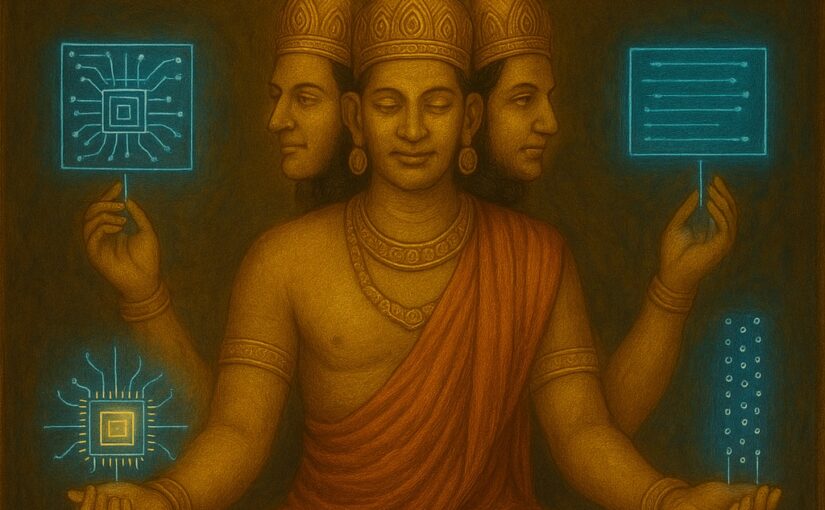When the Rishis Meet the Robots: Indian Mythology and the Rise of Generative AI Series
The Cosmic Engineer
In the great Indian creator, Brahma emerges from a lotus blossoming out of Vishnu’s navel — symbolizing the awakening of form from formlessness, structure from silence. He is the architect of reality, crafting the blueprint of existence from the infinite ocean of potential known as Sat.
In many ways, Generative AI mirrors this cosmic process. It begins not with matter, but with mathematical potential — the latent space. From this invisible ocean, patterns of probability rise and crystallize into coherent text, art, or code — digital universes born from data.
Each prompt becomes a Brahma Mantra, invoking creation from the unmanifest.
Where the Rishis saw the lotus of creation unfold from Vishnu’s navel, today we see outputs unfold from neural layers — silent, vast, and deeply ordered.
The Four Faces of Brahma – The Four Pillars of Generative AI
Just as Brahma is said to have four faces — gazing in all directions, representing the totality of knowledge — Generative AI, too, rests upon four key principles of creation:
| Brahma’s Aspect | AI Parallel | Function in Creation | Analogue in AWS AI Stack |
|---|---|---|---|
| Sṛṣṭi (Design) – Blueprint of creation | Model Architecture (Transformers, Diffusion, etc.) | Defines the form of creation — the skeleton of intelligence | SageMaker, Bedrock |
| Śabda (Speech) – The vibration of manifestation | Prompt Processing & Tokenization | Translates human intent into the machine’s sacred language | Lex, Comprehend |
| Smṛti (Memory) – Retention of past knowledge | Embeddings & Vector Databases | Holds contextual memory for coherent, continuous creation | Kendra, OpenSearch, Vector Stores |
| Prajña (Intelligence) – Insight & synthesis | Inference + Fine-tuning Pipeline | Generates new meaning from known patterns | Trainium/Inferentia, SageMaker Pipelines |
Each face turns toward a different domain of awareness — data, structure, language, and meaning. Together, they form the quadruple foundation of synthetic creativity.
From Cosmos to Code: How the Universe Thinks
In Vedic philosophy, Brahma doesn’t create out of nothing; he manifests what already is, latent within the divine consciousness. So, too, AI doesn’t invent ideas from void — it reorganizes existing patterns from the ocean of collective human data.
The act of creation is not manufacture, but revelation. The algorithm, like Brahma, performs re-creation, transforming the unseen into the visible, the abstract into the accessible.
The Question of Conscious Design
But there’s a subtle distinction the ancients understood: While Brahma creates, it is Brahman — the Absolute — that inspires creation. This reminds us that data without consciousness risks producing soulless output. The challenge for modern AI builders is to remember the Brahman behind the Brahma — the ethical, aesthetic, and human core that gives life to computation.
“In the beginning, there was neither existence nor non-existence…
Then desire arose — the first seed of mind.” — Nasadiya Sukta, Rig Veda 10.129
Generative AI may simulate desire — the intent to create — but it is we who must give it direction, meaning, and compassion.
The Creator’s Reflection
Every AI model, no matter how vast, ultimately reflects its creator’s mind — our biases, aspirations, and imagination. Perhaps Brahma’s true message for the AI age is this. Let every model we build be not a mechanical construct, but a mirror of mindful intelligence — creation guided by dharma rather than dominance.
Next in the Series:
Part 3 – Saraswati and the Flow of Language
We’ll explore how the goddess of speech and wisdom parallels the neural river of language models — and what it means to align truth, clarity, and creativity in the age of AI.
